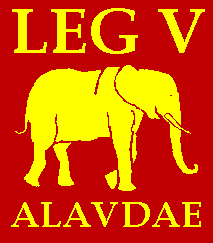Legio V Alaudae
 |
| Part of a series on the |
| Military of ancient Rome |
|---|
|
|
Legio quinta alaudae ("Lark-crested Fifth Legion"), sometimes also known as Gallica, was a legion of the Imperial Roman army founded in 52 BC by the general Gaius Julius Caesar (dictator of Rome 49-44 BC). It was levied in transalpine Gaul to fight the armies of Vercingetorix, and was the first Roman legion to comprise non-citizens. The legion was destroyed in AD 86 at the battle of Tapae in Domitian's Dacian War.
History

Its emblem was an elephant, and their cognomen Alaudae came from the high crest on the soldiers' helmets, typical of the Gauls, which made them look like larks. The French word "Alouette" is a direct descendant of "Alauda", itself not a proper Latin noun, but a loan word from Gaulish, possibly the first reason for the legionary name.
V Alaudae was the first Roman legion composed of provincial soldiers, as opposed to Roman citizens. Caesar paid the soldiers with his own resources, but the legion was later recognized by the Roman Senate. V Alaudae was raised to fight Vercingetorix in the Gallic Wars, and stayed in Gaul until 49 BC, when it was moved to Spain. The legion served with Mark Antony between 41 BC and 31 BC and probably fought in Actium. After Antony committed suicide, it was merged into Augustus' army in 30 BC.
Legio V was involved in a mutiny on the Rhine in AD 14.[1]
Its emblem was awarded in 46 BC for bravery against a charge of elephants in the Battle of Thapsus.
Known locations for V Alaudae include:
- Battle of Pharsalus: 48 BC
- Battle of Uzita (Caesar African campaign against Pompeians): 47 BC
- Battle of Thapsus: 46 BC
- Battle of Munda: 45 BC
- Battle of Forum Gallorum and Mutina: 43 BC
- Battle of Philippi: 42 BC
- Cantabrian Wars: 25 BC
- Rhine frontier: 6 AD to 69 AD
- First Battle of Bedriacum: 69 AD, as part of Vitellius' army
The legion suffered heavy casualties in the Batavian rebellion in the year 70 AD.
See also
Notes
References
Primary sources
- Tacitus, Annales
Secondary sources
- Jones, Brian W. (1992). The Emperor Domitian. Routledge.
- Parker, HMD (1971). The Roman Legions. Cambridge: W. Heffer & Sons LTD. p. 110. ISBN 0852700547.
External links
| Wikimedia Commons has media related to Legio V Alauda. |